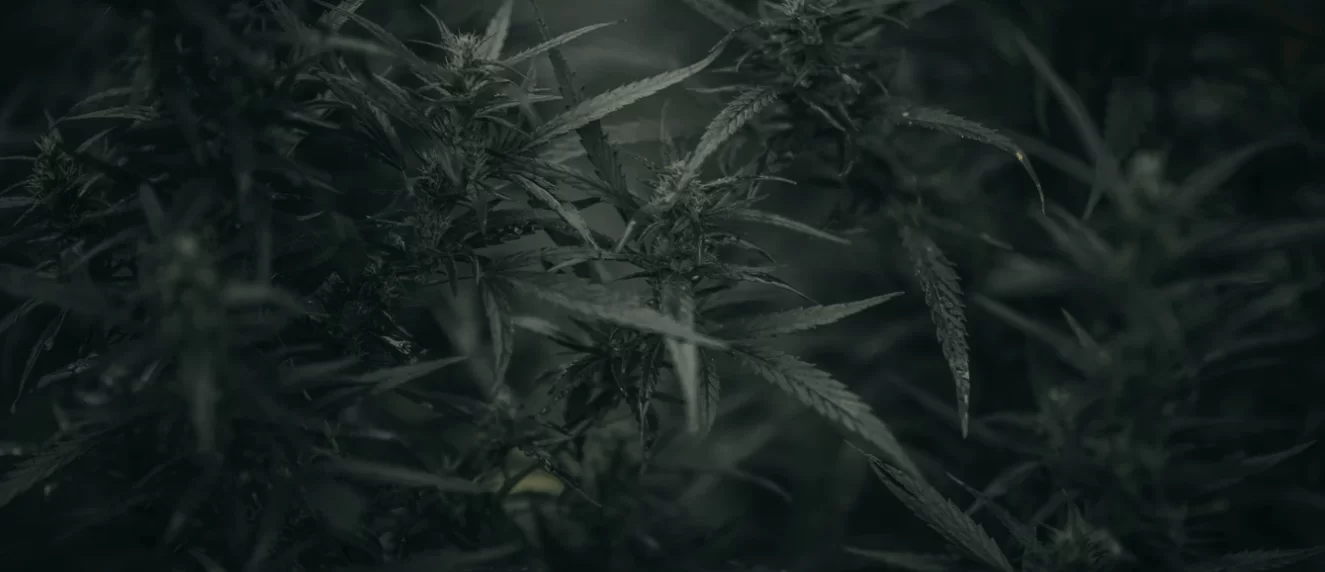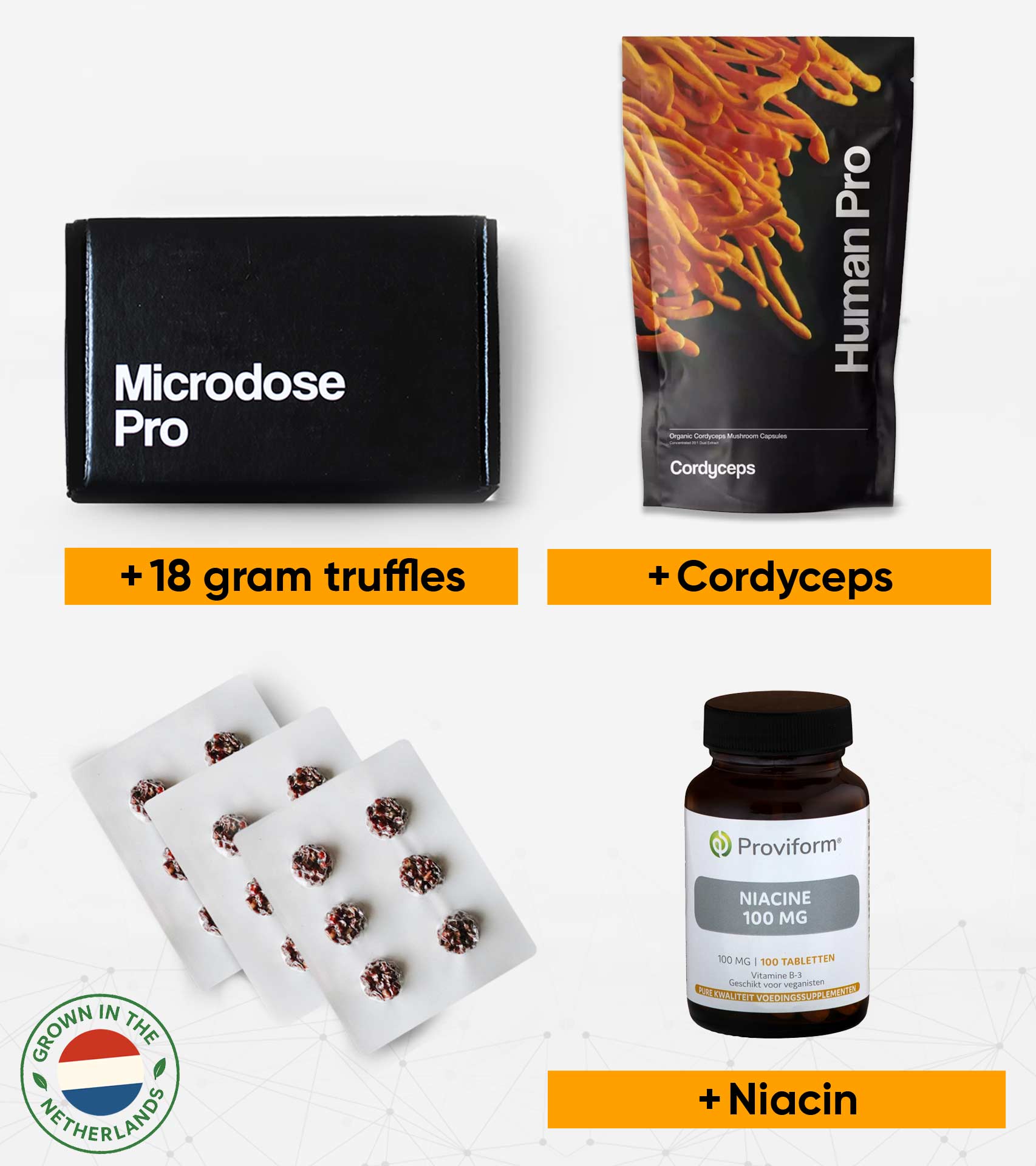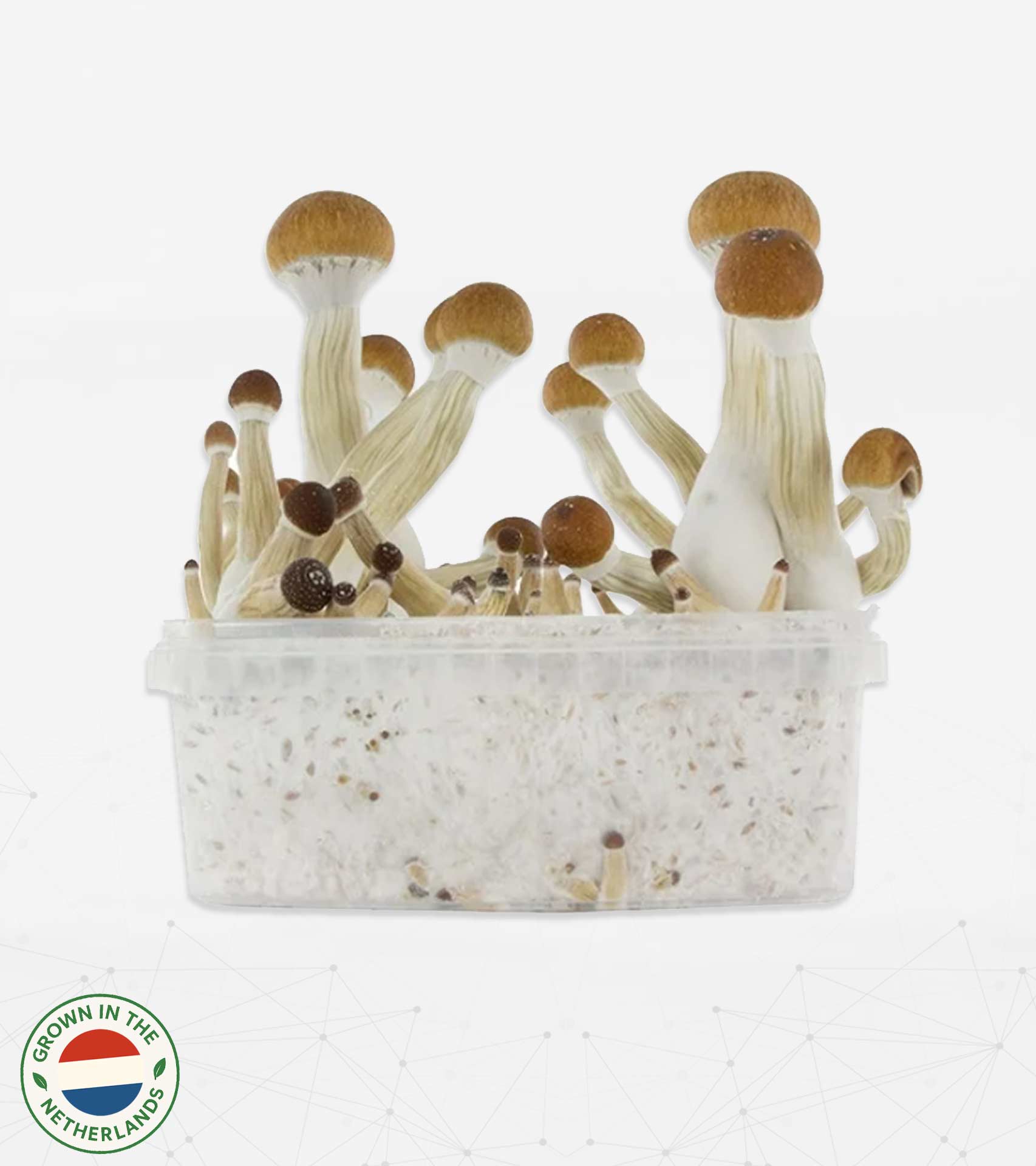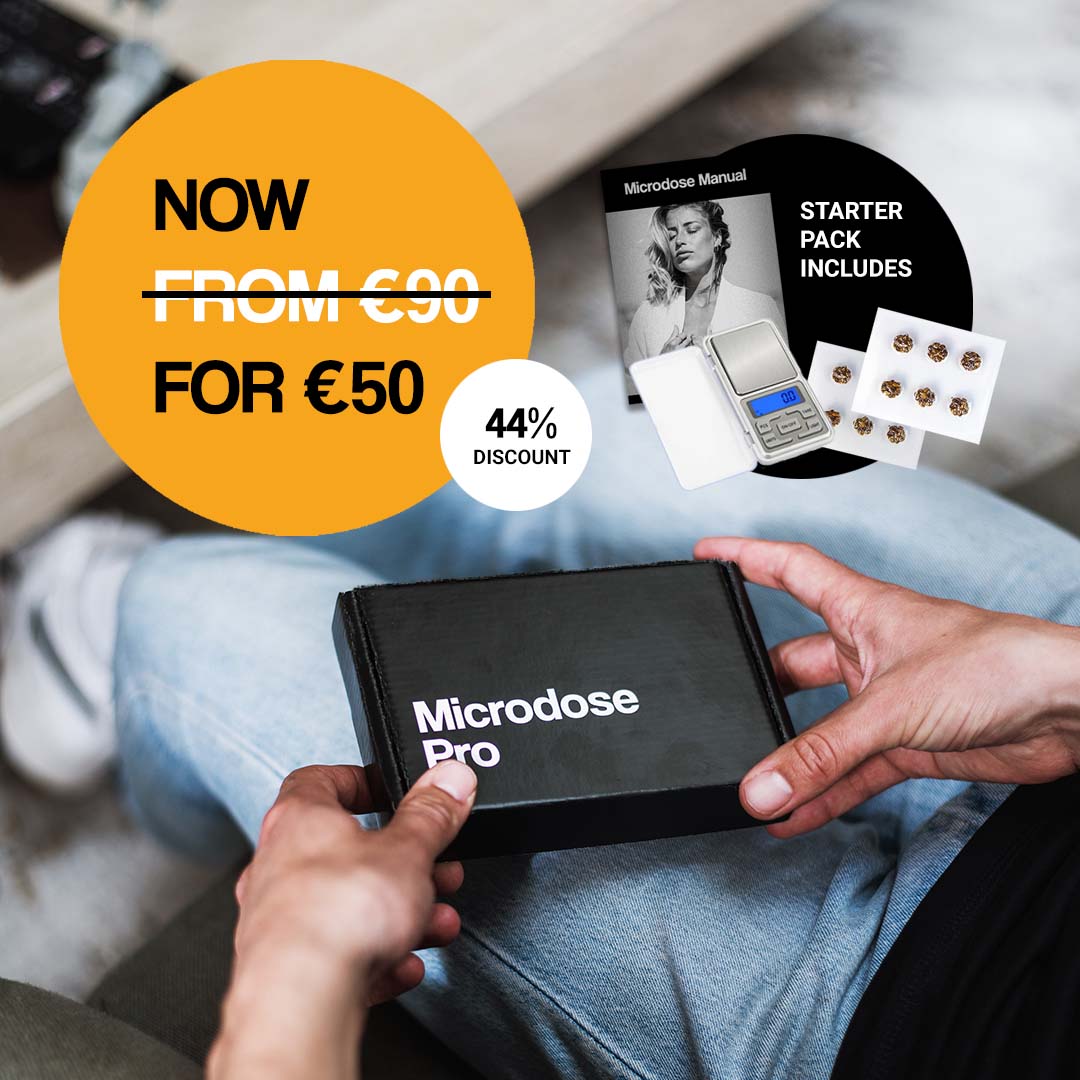The Netherlands’ foremost guides on microdosing explore the world’s most popular psychedelic plant – and its benefits when enjoyed on a very small scale.
Welcome to the right place – if what you’ve been searching for is an informative and erudite guide to microdosing cannabis – also known as Marijuana, Astro turf, Aunt Mary, Canappa, Cheeba, Ganja, Dagga, Herb, Hemp, and hundreds of other names. After coffee, alcohol, and nicotine, it is the most consumed substance in the world – and you happen to be reading this article at a very interesting time in the history of cannabis, around which global legislation prohibiting its use is rapidly loosening.
What is microdosing?
Microdosing is a fast-growing lifestyle trend in which an individual regularly consumes very small amounts (literally, micro amounts) of a psychedelic substance or substances, every few days for several weeks – to reduce anxiety, alleviate depression, sharpen focus, improve creativity, heighten the senses, make socializing easier, raise energy levels – or any combination of these aspects of being.
In general, microdosing involves taking about one-tenth of the usual “recreational” dose of a psychedelic, so that the effects on mind and body are purely positive, very mild, and unlikely to impact day-to-day capabilities or behavior. The intent with microdosing is not to get “high” when you’re feeling low, but to achieve a median, optimal state of mind.
What is cannabis?
Cannabis, as most people know, is a psychoactive substance sourced from the Cannabis plant. It is used primarily for medical or recreational purposes. The main psychoactive component in cannabis – the thing that makes it a psychedelic substance – is called tetrahydrocannabinol, or THC for short. Cannabis can be consumed by smoking, vaporizing, within food (called “edibles”), or as an oil or tincture. Cannabis is most easily recognized by its dark green, fan-shaped compound leaves – but there are at least ten non-psychedelic plants that look like cannabis, yet aren’t.
Are there different types of cannabis?
Yes, there are hundreds of different strains of cannabis, maybe even thousands or tens of thousands of strains. The many different strains may differ quite widely in terms of taxonomy, and their psychoactive potency can vary from strain to strain. The three primary strains of cannabis are called Cannabis sativa, Cannabis indica, and Cannabis ruderalis. Sativa grows the biggest, with its long slender branches growing up to 15 feet in height, and is said to have originated in India. Large-scale cannabis growers favor it as it flourishes in the outdoors, where its large, long lives easily drink up the sunlight. Sativa is the strain most often used as an icon in artistic applications – album covers, T-shirts, tattoos, etc.
Indica is much smaller, growing only from 3 to 6 feet in height and having a bushier, sturdier form. Indica can grow quite well indoors, unlike sativa which needs a lot of space. Ruderalis is not as common as indica or the cannabis “superstar”, sativa, as it grows to a very small size and certainly, as with indica, does not offer quite as much potency as sativa in terms of its psychoactive properties.
Out of experimentation with these three primary strains, an almost infinite number of sub-strains have been developed by growers, who might be striving to cultivate either a higher content of THC – the psychoactive compound in cannabis – or a higher content of CBD, a non-psychedelic compound in cannabis that can aid relaxation and has other wellness and medical, rather than recreational, uses. Some growers are simply aiming for a certain aroma and flavour in their strains.
Every year, the recreational cannabis community circulates recommendations on the best new or existing strains on the market, with some legendary strains, like Durban Poison, usually staying high up in the rankings.
What is hydroponic cannabis?
While natural “bush weed” is grown outdoors, hydroponic cannabis is grown indoors under more controlled laboratory-style conditions including 24-hour electric lighting, circulating water and the addition of nutrient-rich solutions into the cannabis. In countries where legislation around cannabis is very strict, cultivating it hydroponically, behind closed doors, can make it easier to hide from the authorities. Although scientific evidence doesn’t really back it up, a lot of people say that they find hydroponic cannabis a lot stronger than bush weed.
What are synthetic cannabinoids?
Although often marketed as natural cannabis, synthetics or “fake weed” definitely are not. Hundreds of synthetic varieties exist and are usually a mix of various herb leaves with sprayed-on, lab-created chemicals. These chemicals are often complete unknowns and medical experts warn that synthetic cannabinoids can have serious health consequences.
In July 2018, the USA’s Food and Drug Administration warned consumers that a batch of synthetic marijuana had been laced with rat poison and there are frequent accounts in which synthetic cannabinoids contained harmful substances of one sort or another. In short, although they can be acquired for temptingly low prices, synthetics are best avoided – read more about the health risks here.
What is the history of cannabis?
As with other naturally occurring psychedelics like certain types of mushrooms, mescaline or iboga, whose use can be traced back to ancient times, the origins of cannabis stretch back to 500 BC, when ancient cultures used it within herbal medicine, rather than for its psychedelic properties. Its origins stretch back even further still, to 2 727 BC, when the oldest known written record of cannabis use has been identified in China.
Ancient Greeks and Romans were also familiar with cannabis while, in the Middle East, the use of “hashish” – derived from cannabis resin, rather than from the leaves, spread across the Islamic empire and into Africa. In the Americas, early Western colonists grew hemp for textiles and rope, however, indigenous Americans had already been using cannabis for centuries as an aid to wellness (it likely found its way into a good few “peace pipes” along the way, too). In a similar pattern, 17th Century Dutch settlers in South Africa found that the plant was already being used by the indigenous Khoisan and Bantu peoples.
By the middle of the 19th century, cannabis was being quite widely used in the West as one of the secret ingredients in so-called patent medicines. Without any significant measure of restriction, medical practitioners were experimenting with its psychoactive properties, both on themselves and on their patients.
Towards the end of the 19th century, the general consensus was that cannabis could have both positive and negative effects on people, meaning that its use ought to be controlled by stricter legislation. Many countries started to require that medicine manufacturers list ingredients including cannabis on their product labeling, as skepticism around its benefits to society began to grow.
20th Century: Clampdown time
Although there are records of cannabis use being prohibited in earlier times (perhaps the earliest recorded incidence was when Soudoun Sheikouni, the emir of the Joneima in Arabia, prohibited its use in the 1300s), the law really began to knuckle down on cannabis around the start of the 20th Century.
In 1906 in the United States, the District of Columbia was the first to restrict the sale of cannabis. Curiously, it was outlawed in Jamaica (then under British rule) in 1913. It was also prohibited in South Africa in 1922 and in the United Kingdom and New Zealand in the 1920s. Canada criminalized it in 1923. In the 1930s, the USA restricted cannabis use unless a heavy tax was paid and, in the 1950s, two US laws were passed that would set the stage for the prolonged “war on drugs” that was to follow, from the 1960s to 1990s. Under the Narcotics Control Act of 1956, first-time possession of cannabis could lead to two to ten years in prison.
Cannabis and counterculture
Such laws did little to stem the spread of cannabis use, which reached its height in the 1960s; the decade of counterculture in which cannabis, LSD, and other psychedelics became widely associated with “hippies” and were popularised in literature, rock and roll, film and art. As far as cannabis having a dignified public image was concerned, this era was a PR disaster as it diverted nearly all attention away from the many significant benefits of cannabis, and onto the freewheeling and often rebellious behavior of its most vocal advocates.
During the 1980s, it was estimated that around 200 million people worldwide were using cannabis on a regular basis – but almost two decades would pass before the medical fraternity began to seriously study and reassess cannabis.
1990s: cannabis as medicine once more?
In 1990, an anonymous survey of members of the American Society of Clinical Oncology sought to measure the attitude of American oncologists regarding the antiemetic (treatment for vomiting and nausea) use of cannabis in cancer chemotherapy patients.
Surprisingly, almost 50% answered that they had recommended using cannabis to at least one patient. This was quite a revelation to the medical fraternity and the legal use of marijuana within medical treatment continued to be pursued throughout the 1990s, with numerous court applications both for and against removing the “schedule one” status of the THC compound in cannabis.
A big milestone was reached in California in 1996 when the US state-permitted patients and their primary caregivers to possess and cultivate marijuana for the treatment of AIDS, cancer, muscular spasticity, migraines, and other disorders. Caregivers were also protected from punishment should they recommend cannabis to their patients.
Many US states would follow California’s example in the years to come and, around the world, the late 1990s and early 2 000’s saw medical cannabis legalized in a number of countries including Italy, Israel, Finland, and Canada.
Why did restrictions begin to ease around medical cannabis?
Simply put, the many benefits of cannabis within medical care were becoming too consistently demonstrated to overlook, and many legislators decided that its use should be permitted – as long as this was under the authority of licensed medical professionals.
Some of the main medical benefits of cannabis include chronic pain relief; increased lung capacity (contrary to popular belief!); the regulation of diabetes; as a possible contributor to resisting forms of cancer, and as a treatment for depression (read more on the top 20 medical benefits here).
Intriguingly, 2020 has seen a steep rise in the purchase of medical cannabis, with early research tentatively suggesting that it may be able to combat some of the symptoms of COVID-19: “CBD has anti-inflammatory properties … Whole plant cannabis extracts have also been shown to reduce blood coagulation (clotting) in animal models; it is known that many of the negative systemic effects of COVID-19 appear to be related to altered coagulation”.
At this time, medical patients in some 33 states in the USA are using cannabis to relieve a variety of conditions or symptoms. Around the world, the market for medical cannabis is now thriving, and is set to grow by USD 22 billion by 2024, according to research by Technavio.
What are the benefits of microdosing cannabis?
The main “problem” with cannabis is the THC: too much of this psychoactive compound can lead to drowsiness, memory loss, muddled thinking and memory (conversely, studies with mice have shown low doses to have a positive effect on memory). Many people want the therapeutic benefits of cannabis without getting “high” – and that’s where microdosing provides the solution.
Nowadays, many people are using CBD-infused products or cannabis microdoses to enhance their daily mental or physical activities, in the same way others might turn to energy drinks or coffee. Microdosing cannabis can help with many things including pain, arthritis, depression, stress, and anxiety. It may ameliorate digestive conditions like inflammatory bowel disease, Crohn’s disease, and ulcerative colitis. For all these reasons, the line between medical cannabis and microdosing cannabis has become increasingly blurred, with many medical practitioners guiding patients to follow a microdosing protocol with their cannabis.
Many people with none of the above challenges are simply looking to take “the edge” off; to remove that mild, underlying feeling of anxiety and unease, and to enter a calmer, less distracted state where focusing on the activities at hand becomes easier. Some people also microdose cannabis for the same reason they might have a glass or two of wine; to reduce anxiety in social situations.
Charlotte Palermino, writing for Cosmopolitan a couple of years ago, diarised a week of microdosing cannabis and mentioned another benefit we haven’t touched on: better sleep – “my sleep was regular and consistent. As a result, my eye bags were nowhere to be seen and my energy levels, other than the few moments where I took too many edibles, were higher than average.”
What are the risks of microdosing cannabis?.
An obvious risk is of course falling afoul of the law – this quick-check map on Wikipedia will give you a good idea of the legal status of cannabis, whether recreational or medical, in various countries around the world.
Apart from that, there is generally thought to be very little risk in microdosing cannabis – unless you start experimenting with too high a dosage (this can be a temptation, as different people will respond to different dosage levels and it can take a while to find the right level for you). Some of the symptoms of having too much cannabis include tremors or “the shakes”, having a dry mouth, feelings of nausea, paranoia, anxiety, drowsiness, and confused thinking. If you’re microdosing with cannabis and start feeling any of these things to a degree, you may need to reduce the dosage you’re taking and/or the frequency of your microdosing.
How do you microdose with cannabis?
As mentioned, finding the optimal dosage level of cannabis is a challenge that varies from person to person, but it is an important first step. For this reason, Dustin Sulak, a physician based in Maine, USA, advises taking very small amounts of cannabis over the course of several hours in a day, until you feel you have found a comfortable dosage. He also suggests holding off on microdosing for two days before your next microdosing day. This would do two things if you follow it – prevent your tolerance to the cannabis building up, and allow you to objectively how your microdosing went – did you take too much, too little or just enough?
As reported on Leafly, Michelle Ross, who focuses on cannabis treatments for medical patients, suggests that microdosers start off at 2.5 milligrams, run with that level for three days, then increase if necessary.
Cannabis can come in different forms – which is best for microdosing?
Because the priority with microdosing is to be able to settle on the right micro-dosage, the best form to microdose with is probably edibles, where you can more easily measure grams and micrograms. The only drawback with edibles is that it can take much longer for any effects to become evident. Oils or tinctures are also a very good option and arguably quicker – always look for THC levels on the labeling and look out for those products that tell you exactly how many milligrams are in each drop.
Finally, there is smoking or vaping cannabis, which involves guesswork more than measurement – taking a small hit and then giving it a while to see what happens, before taking the next small hit.
Journaling your microdosing experience
Microdosing journaling is the process of tracking your daily experience of microdosing cannabis, whether through written entries or audio/video recording. This is a good thing to do, for two reasons:
- Journaling your experiences with cannabis will help you to track the effects of the doses you take on your microdosing days, judge whether they are too high or low, and assess the effects of the microdosing on your off-days between dosing days.
- Chronicling your experience of microdosing cannabis will create useful learning material for other people new to microdosing, who will learn from what you have learned.
Where can you get cannabis for microdosing?
Many countries have official bodies that can assist with obtaining medical cannabis. Here in the Netherlands, for example, the Office of Medical Cannabis acts as a central resource and distributor of medical cannabis to pharmacies, pharmacy-holding GP’s, hospitals, and veterinarians. In the UK, Cannabis Access Clinics is an online resource for both doctors and patients. Over in the States, restrictions on medical cannabis vary from state to state so you’d need to do a state-based search for helpful resources in those states where it is legal.
In the Netherlands, you can get recreational cannabis in small amounts or as seeds at many coffee shops and corner stores (here’s a handy shopper’s guide for Amsterdam) and there are a number of resources where you can buy online, like Weedhuis. Oils and tinctures may also be found at certain health stores.
Thank you for reading, enjoy your cannabis microdosing experience if this is where it begins and, if you’d like to find out more about the wider world of microdosing with other psychedelics, you may enjoy this microdosing overview.
Sources:
https://en.wikipedia.org/wiki/Cannabis_(drug)
https://www.ohiomarijuanacard.com/post/microdosing-cannabis-the-benefits-without-the-high
https://medium.com/better-humans/how-one-year-of-microdosing-helped-my-career-relationships-and-happiness-715dbccdfae4
https://thethirdwave.co/microdosing/marijuana/
https://www.narconon.org/drug-information/marijuana-20th-century.html
https://www.deamuseum.org/ccp/cannabis/history.html
https://wayofleaf.com/cannabis/101/different-kinds-of-marijuana
https://www.psytech.biz/the-netherlands-is-psychedelic-friendly/
https://www.iflscience.com/health-and-medicine/psychedelic-drugs-can-help-alcoholics-stop-drinking-according-new-study/
https://www.medscape.com/viewarticle/924368
https://www.thecut.com/2018/05/microdosing-guide-and-explainer.html
https://www.wweek.com/culture/2017/04/18/i-tried-microdosing-with-four-different-psychedelic-drugs-heres-what-happened/https://www.wired.com/story/a-microguide-to-microdosing-psychedelic-drugs/
https://sites.google.com/view/microdosingpsychedelics/home
https://en.wikipedia.org/wiki/Drug_policy_of_the_Netherlands
https://thethirdwave.co/microdosing
https://en.wikipedia.org/wiki/Microdosing




